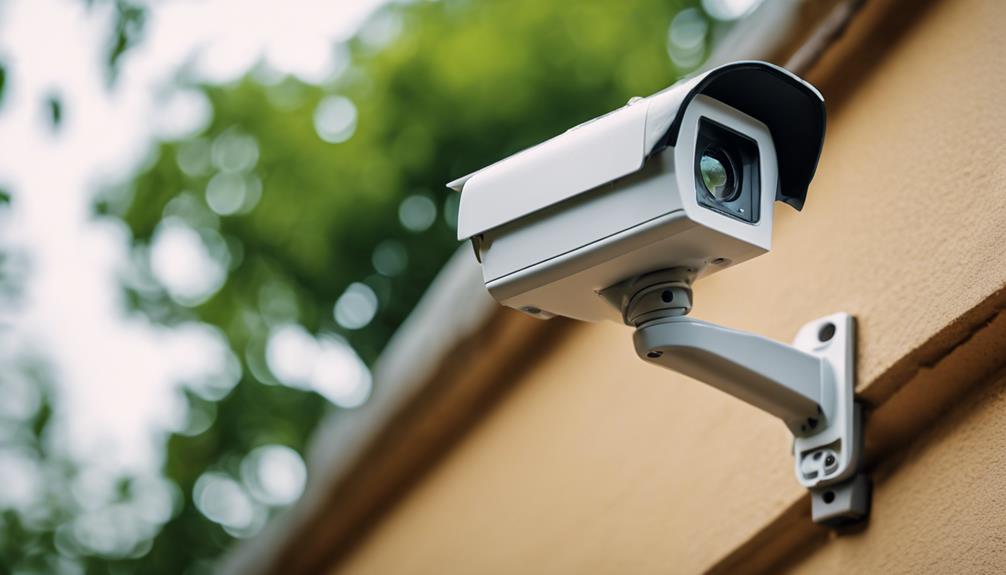In order to ensure optimal performance from your Ring doorbell, it is important to aim for an RSSI level of approximately -40 dBm. This level is crucial for clear video quality and timely alerts. If your RSSI level drops below -65 dBm, you may experience connectivity issues that can impact the functionality of your doorbell. Factors such as being more than 30 feet away from your router or physical barriers can weaken your signal strength. It is recommended to regularly check the RSSI level using the Ring app and consider adjusting the position of your doorbell or router to improve the signal. By staying informed about these strategies, you can maintain an ideal RSSI level and enhance your overall Ring experience.
Key Takeaways
- The ideal RSSI level for Ring Doorbell performance is around -40 dBm for clear video and alerts.
- Acceptable RSSI range is -41 to -65 dBm, with possible occasional video streaming issues.
- RSSI below -70 dBm signals potential connectivity problems and degraded performance.
- Maintaining a distance of 1-30 feet from the router enhances signal strength and RSSI.
Understanding RSSI Basics
Understanding the basics of RSSI is vital for guaranteeing your Ring doorbell operates effectively and delivers high-quality video.
RSSI, or Received Signal Strength Indicator, measures the strength of the wifi signal your Ring devices receive. It's expressed in negative numbers; the closer the value is to 0, the stronger the signal. For instance, an RSSI of –40 dBm indicates excellent signal strength, while values below -70 dBm suggest you're facing connectivity issues.
Maintaining a strong signal is essential, especially in areas where indoor air quality is compromised by allergens or pollutants, as a poor connection can lead to interruptions in monitoring your home environment regular filter changes improve efficiency.
To maintain peak performance, it's important to aim for an RSSI level of -40 dBm or better. Readings around -60 dBm or higher may lead to unreliable connections, resulting in video lag or disconnection.
Regularly monitoring your RSSI levels through the Ring app can help you stay informed about your wifi signal strength. If you notice a drop in RSSI values, consider repositioning your router or the Ring doorbell to improve the signal.
Ideal RSSI Levels

To get the best performance from your Ring doorbell, you need to understand the ideal RSSI levels.
A strong signal, ideally around -40 dBm, guarantees clear video and timely alerts. This is particularly important as balancing innovation and privacy rights remains a challenge in the deployment of smart home technologies.
If your RSSI falls below -65 dBm, you might face connectivity issues that can affect functionality.
Optimal RSSI Ranges
Achieving an ideal RSSI level for your Ring doorbell is essential for guaranteeing reliable performance and clear video quality. The best RSSI ranges for your device can greatly impact its functionality. Ideally, you want an RSSI level of -40 dBm or better, as this indicates excellent connectivity and minimal interference, allowing for smooth operation and crisp video feeds.
For those interested in home aesthetics, a well-placed doorbell can also enhance the overall look of your entryway, incorporating elements of farmhouse front door charm.
If your RSSI falls between -41 and -65 dBm, you're still in an acceptable range, but you may experience occasional video streaming issues. An RSSI reading of -66 to -90 dBm suggests poor signal strength, leading to potential connectivity loss and degraded performance. To maintain reliable alerts and best operation, it's best to aim for levels closer to -50 dBm.
Regularly monitoring your RSSI levels through the Ring app can help you identify any performance degradation over time. By keeping an eye on these readings, you can address issues before they affect your doorbell's functionality.
Signal Strength Impact
Your Ring doorbell's performance directly hinges on maintaining an ideal RSSI level, as even slight variations can considerably impact video quality and connectivity.
The best RSSI level for your device is –40 dBm or better, ensuring excellent signal strength and minimal interference. When your RSSI falls between -41 dBm and -65 dBm, you might still get acceptable connectivity, but you could start to notice video quality issues, especially as it approaches -60 dBm.
Regularly monitoring your RSSI levels can help you catch potential issues before they affect your device's performance. Additionally, understanding the impact of keyword clustering on your content strategy can enhance your overall user experience with your Ring device.
If your RSSI drops to -66 dBm or worse, you'll likely face poor signal quality, leading to connection loss and performance degradation. Keeping your RSSI closer to -50 dBm is essential for ensuring reliable alerts and clear video streams from your Ring doorbell.
Factors Affecting RSSI

When it comes to your Ring doorbell's performance, several factors can impact RSSI.
The distance from your router, physical barriers like walls, and electromagnetic interference from other devices all play a role in determining signal strength.
Additionally, the environment in which your doorbell is installed can affect connectivity, much like how artistic expressions unfold in unique settings.
Understanding these elements can help you optimize your setup for the best results.
Distance From Router
The distance between your Ring doorbell and the router plays a crucial role in determining the strength of the signal, with shorter distances yielding better RSSI values. Ideally, you should aim for a distance of 1-30 feet from the router to maintain a strong RSSI of -40 dBm or better.
As you increase this distance, the signal can weaken considerably. Enhancing your home environment with a cottagecore home office setup can also help create a serene atmosphere, which may indirectly influence your focus on maintaining a strong connection.
Each wall or obstacle between your doorbell and the router can degrade the RSSI by approximately 3-10 dBm, further diminishing your wifi signal. So, if you have multiple walls or furniture obstructing the path, your Ring doorbell may struggle to maintain a reliable connection.
Additionally, electromagnetic interference from household devices can amplify this issue, making it even harder for your doorbell to receive a strong signal.
To guarantee the best performance, minimize the distance and obstacles between your Ring doorbell and router. By keeping these factors in check, you can achieve higher RSSI values, assuring your doorbell operates smoothly and effectively, enhancing your home security.
Physical Barriers Impact
Physical barriers like walls and furniture can greatly weaken the Wi-Fi signal to your Ring doorbell, leading to lower RSSI values.
The materials in your walls play a significant role; for instance, concrete and metal can severely degrade the signal compared to wooden walls.
Additionally, the layout of your home and the placement of your devices can influence overall energy efficiency, much like how geothermal energy utilizes the earth's internal heat.
The distance between your Ring doorbell and the router is also vital; the farther they're from each other, the weaker the Wi-Fi connection becomes, resulting in a lower RSSI value.
Obstacles such as large appliances or decorative objects can obstruct the direct line of sight between your router and the Ring doorbell, further diminishing signal strength.
To improve your RSSI, consider reducing these physical barriers by rearranging furniture or moving the router closer to the Ring doorbell.
Ideally, you should aim for an RSSI value of -40 dBm or better for maximum performance.
Electromagnetic Interference Sources
Electromagnetic interference from everyday devices can considerably impact the RSSI for your Ring doorbell, leading to connectivity issues. Common culprits include microwaves, cordless phones, and baby monitors, which operate on similar frequencies, disrupting your Wi-Fi signal.
If you have multiple Bluetooth devices in your home, they can add to this interference, especially in tech-heavy environments. Moreover, physical barriers like walls and metal objects can worsen the effects of electromagnetic interference by further weakening the Wi-Fi signal.
If you live in a densely populated area, you might also face competition from nearby Wi-Fi networks, which can affect the Signal Strength Indicator (RSSI) for your Ring doorbell.
To guarantee a stable network connection, regularly monitor your RSSI values. If you notice consistent drops, consider relocating your Ring doorbell or minimizing interference sources.
Common Issues With Low RSSI

Low RSSI can cause a range of issues, from delayed alerts to poor video quality, making your Ring Doorbell less reliable. When your Signal Strength Indicator (RSSI) number dips below -70 dBm, you face significant connectivity issues that can affect your device's overall performance.
Here are some common problems you might encounter:
- Delayed Notifications: You may not receive alerts in real-time, causing you to miss important events.
- Video Lag: Low RSSI often results in choppy video quality, making it difficult to see who's at your door.
If your RSSI readings fall between -66 and -90 dBm, you might experience intermittent video lag or disconnections, especially during high-demand usage.
Users with lower RSSI values should seriously consider troubleshooting their network setup. Addressing these connectivity issues can improve your Ring Doorbell's performance and help maintain a consistent video feed.
Don't let a poor signal compromise your home security; understanding these common issues is the first step toward a reliable setup.
Tips for Improving RSSI

To boost your Ring Doorbell's RSSI, start by positioning your router within 30 feet of the device for a stronger signal. This proximity helps guarantee better signal strength, which is vital for peak performance.
If that's not feasible, consider using a Wi-Fi extender, like the Ring Chime Pro, to enhance coverage and stability for your Ring devices.
Next, reduce physical obstructions between the router and your Ring Doorbell. Walls, large furniture, and other barriers can greatly degrade your signal. The clearer the path, the better the RSSI will be.
You should also regularly check your Wi-Fi channel. Switching to a less congested channel can help minimize interference from competing networks, improving your overall signal quality.
Community Insights and Support

Engaging with community discussions can provide valuable insights into managing your Ring Doorbell's RSSI and enhancing its performance. By connecting with others who share similar concerns, you can discover effective strategies and solutions tailored to your unique connectivity challenges.
Here are some key benefits of participating in these discussions:
- Real-life experiences: Users often share personal stories about how different RSSI levels impact their Ring devices, giving you a clearer understanding of what to expect.
- Expert advice: Community members frequently offer troubleshooting tips, helping you address common video issues and optimize your setup.
Frequently Asked Questions
What Is a Good RSSI Signal Strength for a Ring Doorbell?
A good RSSI signal strength for your device is around -40 dBm or better. Values between -41 dBm and -65 dBm are acceptable, but anything below -66 dBm may cause connectivity issues you'll want to address.
Is RSSI 70 Good?
RSSI -70 isn't good. It indicates a weak signal that can cause connection issues, poor video quality, and interruptions. You should consider relocating your router or minimizing obstructions for better performance and reliability.
What Is a Good RSSI Signal?
For fantastic functionality, focus on finding a favorable RSSI signal. Ideally, you want readings near -40 dBm for seamless streaming. Anything worse might lead to frustrating flags of poor performance and connectivity issues.
Is RSSI 33 Good?
Yes, an RSSI of 33 is excellent. You'll enjoy a strong Wi-Fi signal, leading to better video quality and minimal connectivity issues. It guarantees your device functions reliably without interference, enhancing your overall experience.
How Does Wifi Channel affect the RSSI for Ring Doorbell?
When setting up your Ring Doorbell, choosing the best wifi channel for ring is crucial for optimal RSSI. A clear wifi channel with minimal interference will result in a stronger RSSI, ensuring a reliable connection. Experiment with different channels to find the one that works best for your specific environment.
Conclusion
In summary, achieving the best RSSI for your Ring Doorbell is essential for seamless performance.
With ideal levels in mind, you can tackle common issues and enhance your device's connectivity.
By implementing the tips provided, you'll feel like you've revealed the secrets to an impervious home security system.
Don't hesitate to reach out to your community for support; together, you can conquer any RSSI challenge and guarantee your doorbell works flawlessly, every time.









